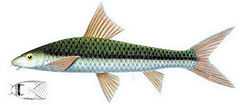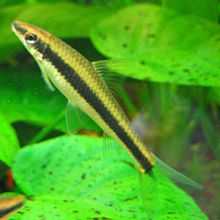Siamese algae eater
| Siamese algae eater | |
|---|---|
 | |
| Scientific classification | |
| Kingdom: | Animalia |
| Phylum: | Chordata |
| Class: | Actinopterygii |
| Order: | Cypriniformes |
| Family: | Cyprinidae |
| Genus: | Crossocheilus |
| Species: | C. oblongus |
| Binomial name | |
| Crossocheilus oblongus Kuhl & van Hasselt, 1823 | |

The Siamese algae eater, (Crossocheilus oblongus or syn. Crossocheilus siamensis), is a species of freshwater fish in the carp family, Cyprinidae. This bottom-dwelling tropical fish is found in mainland Southeast Asia that includes the Chao Phraya and Mekong basins as well as the Malay Peninsula. Their natural habitats are streams and rivers as well as flooded forests during the rainy season. The Siamese algae eater should not be confused with the Flying fox (Epalzeorhynchos kalopterus) or the False siamensis (Garra cambodgiensis).
The Siamese algae eater has a black horizontal stripe extending from opercle to tail. The genuine Crossocheilus siamensis without maxillary barbels and with deeply fringed V-shaped upper lip[1][2] is rarely encountered in the aquarium trade.[3]
Closely related is the Red-algae eater Crossocheilus langei, a species that is widely sold as the Siamese algae eater. It has a bright brownish elongate body with a slightly flat belly. It has a prominent brown-black horizontal stripe extending from nose to tail. This fish may grow up to the length of 16 centimeters. It possesses small maxillary barbels and an unfringed shallowly arcuate upper lip.[4] Two other similar species are traded as Siamese algae eaters, namely Crossocheilus atrilimes,[5] a species that likes to eat Java moss rather than red algae, and an undescribed species of Crossocheilus.[3]

Aquarium care
The information concerns the red algae eater Crossocheilus langei sensu Alfred 1971. This hardy fish is commonly found in the aquarium trade and is one of the most popular and effective tank algae cleaners. They are active and fast swimmers that will school together if kept in a group, but some individuals may display aggression to their own kind or related fishes. In general, the red-algae eater can be kept in most community tanks and are reportedly much less aggressive than similar fishes such as the Chinese algae eater or the red-tailed black shark.
They prefer water temperature range of 24–26°C, a pH range of 6.5–8.0, and a water hardness of 5–20 dH. Because the red algae eaters are effective at controlling the tank algae, many aquarists like to place them in heavily planted tanks with strong lightings that promote the growth of algae. Unlike other aquarium algae eater fishes, the red algae eater is valued for its ability to eat red algae (particularly Audouinella). The fish, however, are opportunistic feeders and will eat pellets and most other food, a tendency that strengthens with age.
The lid of the tank should be properly closed leaving no large hole for the fish to jump out of the tank.
Siamese Algae Eaters will often school together, but are also content living solo. When two are kept together, they will often establish their own territory as they mature. They can be a long-lived fish, ten years experienced.
Remark 1
The binomial Crossocheilus oblongus is massively misapplied in ichthyologic and aquarium literature. Valenciennes in Cuvier & Valenciennes wrote the following description.
Le fond général de la couleur est bleu, foncé sur le dos et s'éclaircissant
sous le ventre; la dorsale, l'anale et la caudale sont jaunes; les
pectorales sont orangées; les ventrales plus pâles.
J'ai fait une description à Leyde sur un poisson long de cinq pouces; mais il paraît que
l'espèce atteint à deux pieds.
His description corresponds to the original colour drawing by Keultjes, Kuhl and Van Hasselt, which was of course known to him according to his protologue. It is a question whether he really described the coloration of the specimen investigated in Leiden as he claimed.
Bleeker alleged the following details in 1853. The original drawing was in his possession during he wrote the description.
colore corpore superne coerulescente, inferne margaritaceo; fascia
cephalo-caudali profunde coerulea; pinnis flavescentibus vel roseis.
Habit. Palembang, in fluviis (Van Leer)
Buitenzorg, Tjampea, Javae insulae, in flumine Tjidani
Longitudo 4 speciminum 67′′′ ad 145′′′.
Mijne voorwerpen behooren stellig tot dezelfde soort
als die, welke Van Hasselt Crossocheilos oblongus noemde en
waarvan hij eene fraaije teekening naliet, welke zich in mijn
bezit bevindt en slechts van de juistheid afwijkt door een te
groot aantal schubben op eene overlangsche rei en door het
niet zigtbare van de bovenkaaksdraden.
It is not clear to me why Bleeker spoke about bovenkaaksdraden, maxillary barbels in English, instead of snuitdraden. Indeed, in the diagnosis of the genus he stated Cirri 2 rostrales. Later he changed his opinion, and the image reproduced above shows a green-coloured fish depicting probably the Palembang population or species.
It remains unsolved whether Crossocheilus oblongus really was a yellow-finned bluish creature as depicted in the original drawing.
Remark 2
The Red Algae Eater of aquariums has two pairs of barbels, the second one miniature and hardly visible without a magnifying device, and a dark anal blotch, as Crossocheilus langei has. Nevertheless, Crossocheilus langei is reported 14.5 cm TL in [6] whereas a rather smaller fish in.[7] To sum up, neither Crossocheilus oblongus nor Crossocheilus siamensis, either of the two species lacking maxillary barbels, is encountered in aquaria, but Crossocheilus langei or an undescribed species related to it.
External links
- Froese, Rainer, and Daniel Pauly, eds. (2011). Crossocheilus oblongus in FishBase. August 2011 version.
- Algae Eating Cyprinids from Thailand and Neighboring Areas
- Simple key to species denoted as Crossocheilus siamensis
References
- ↑ Smith, H. M., Proc. U. S. Natl. Mus. v. 79 (1931) : 20
- ↑ Smith, H. M., The fresh-water fishes of Siam, or Thailand. Bull. U. S. Natl. Mus. No. 188 (1945) : 265
- ↑ 3.0 3.1 Niederle, J., Akvárium terárium 50 (2007), 9–10 : 18–23.
- ↑ Bleeker, P., Acta Soc. Sci. Indo-Neerl. 7 (N. S.2)(1860) : 127
- ↑ Kottelat, M., J. South Asian Nat. Hist. 5 (2000), 1 : 39.
- ↑ Kottelat, M., A.J. Whitten, S.N. Kartikasari and S. Wirjoatmodjo, 1993. Freshwater fishes of Western Indonesia and Sulawesi. Periplus Editions, Hong Kong. 221 p.
- ↑ Tan, H. H. & Kottelat, M. 2009. Ichthyological Exploration of Freshwaters, 20 (1): 13–70.